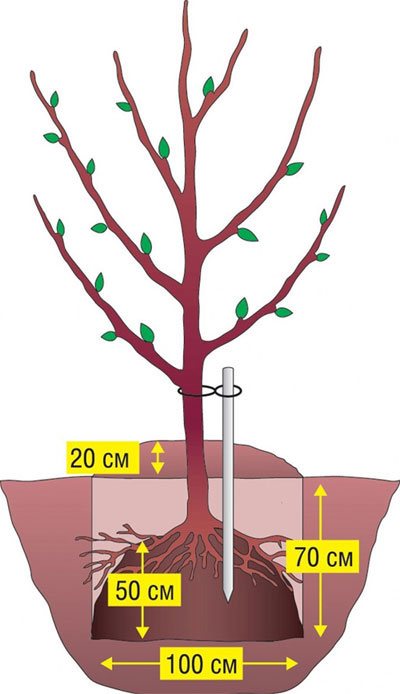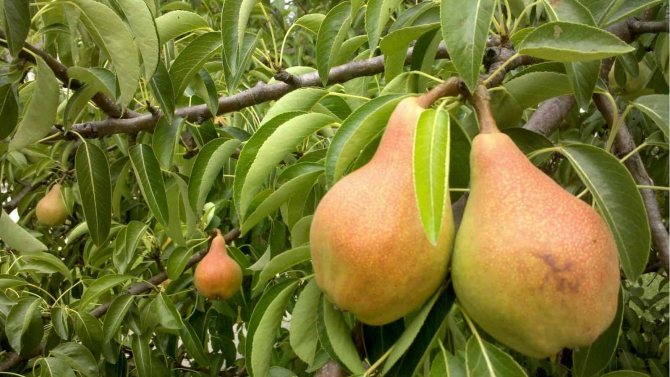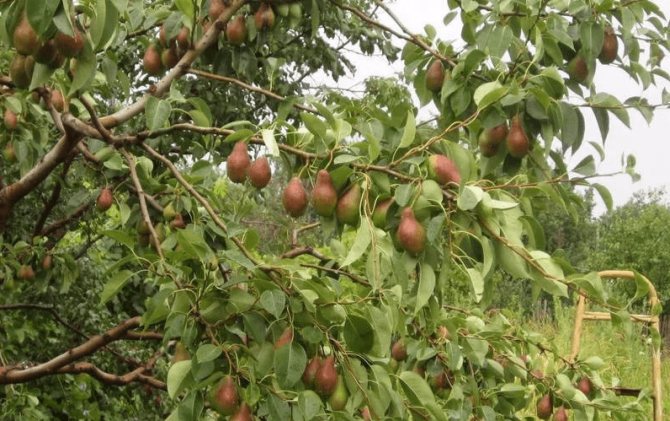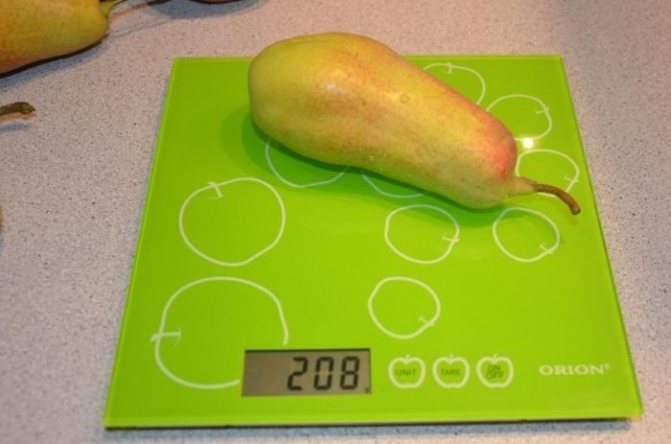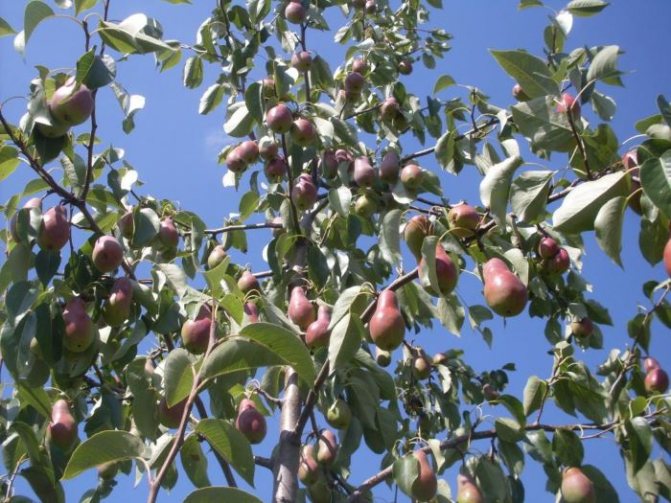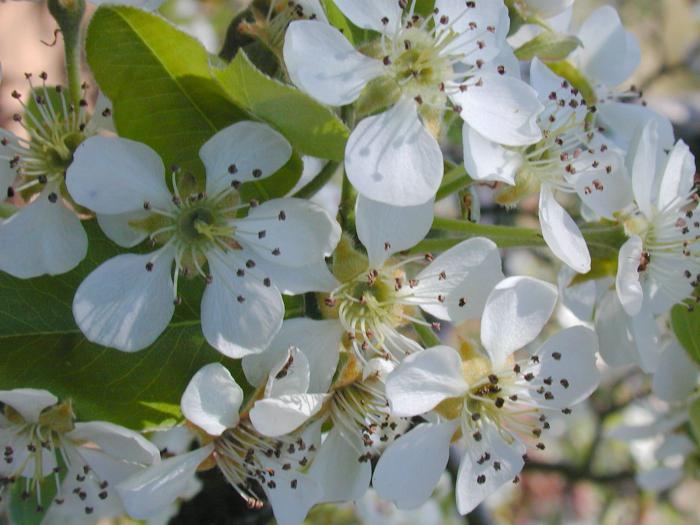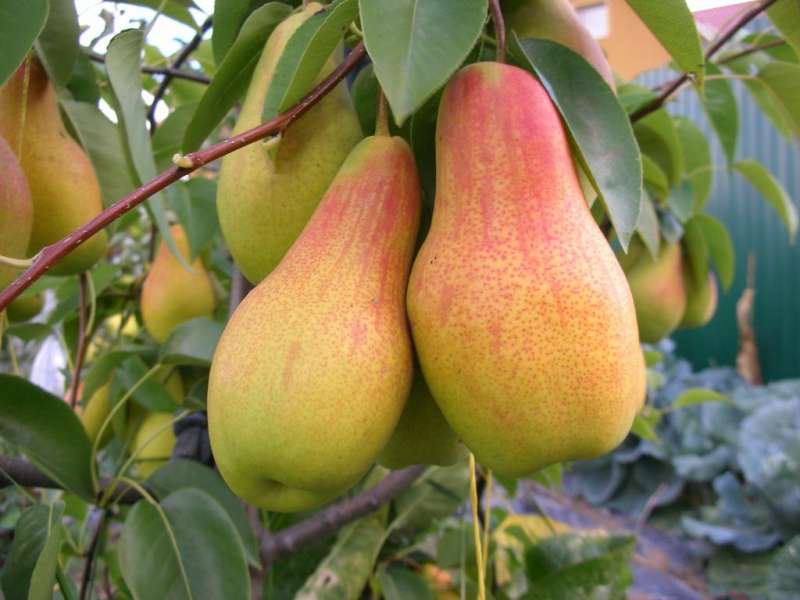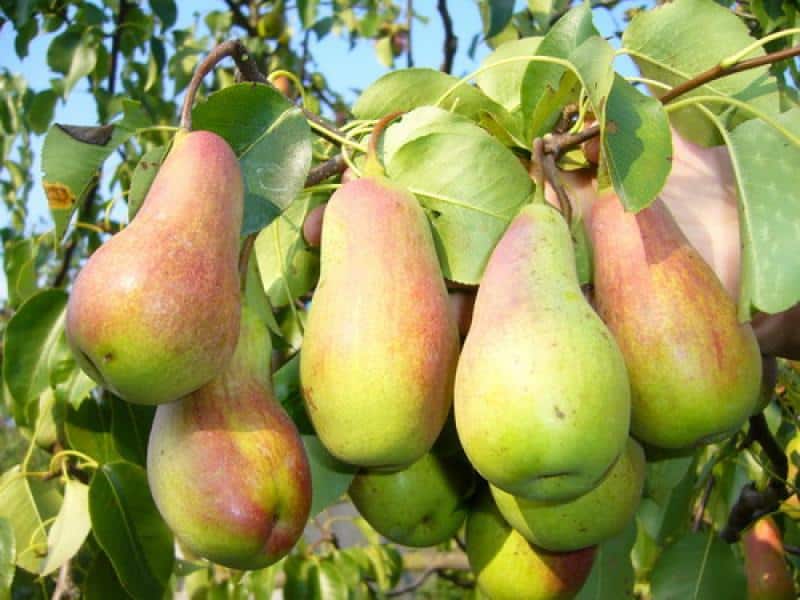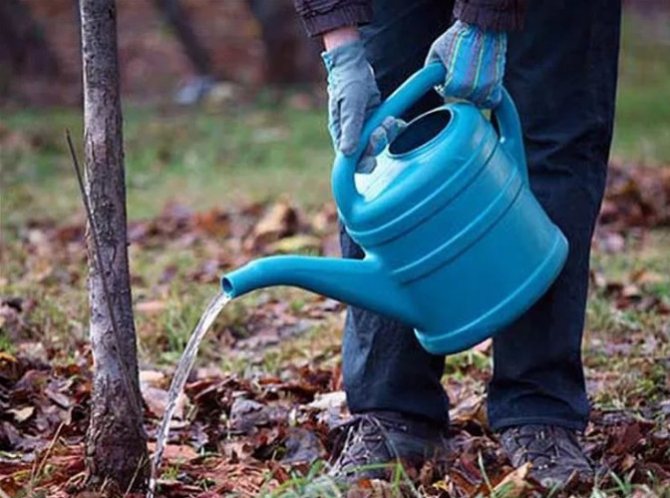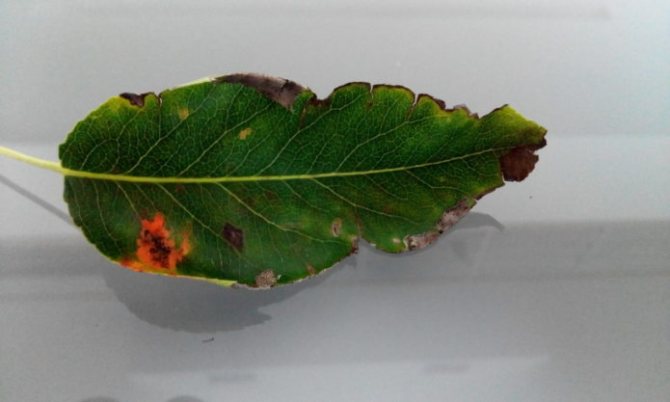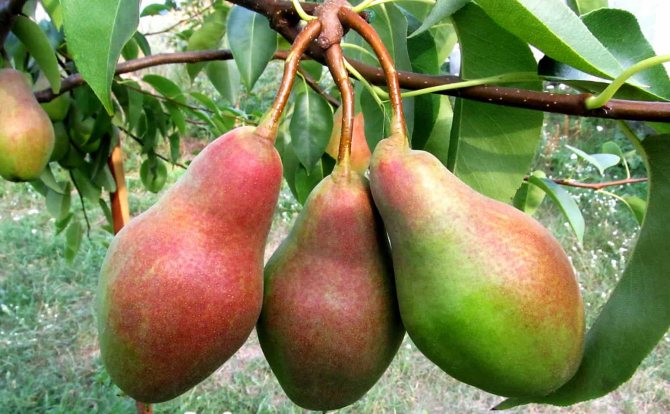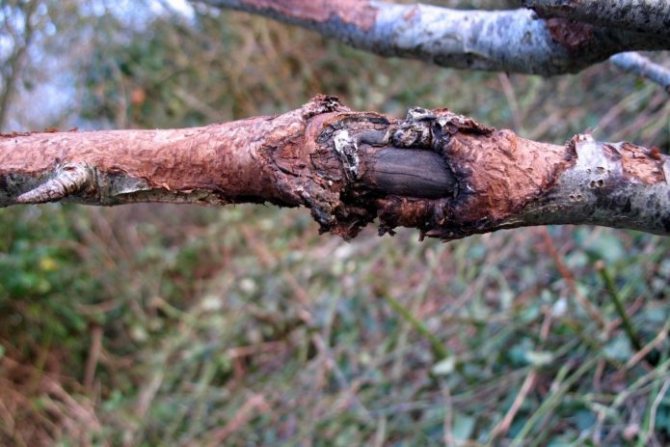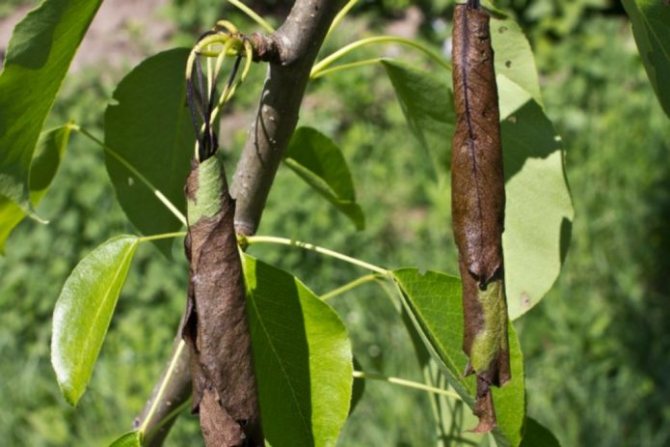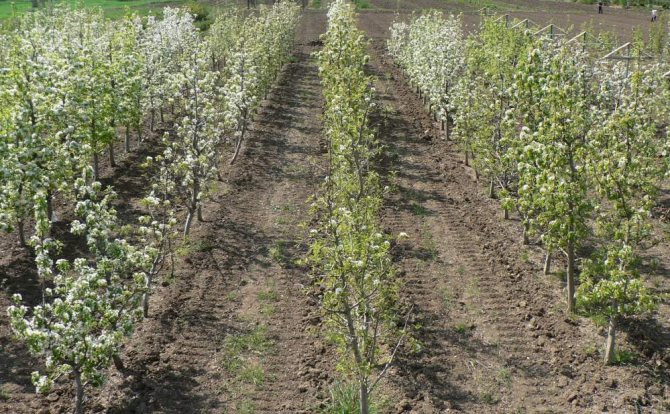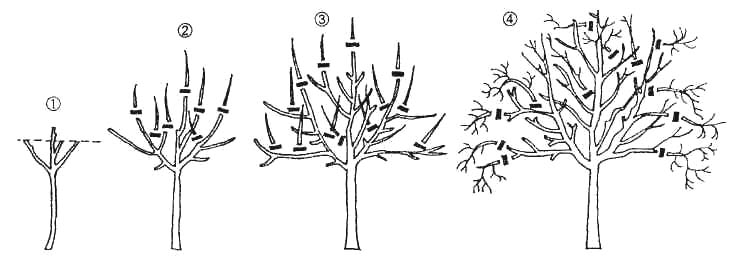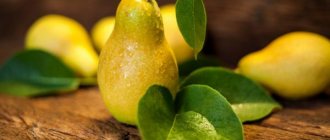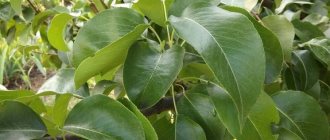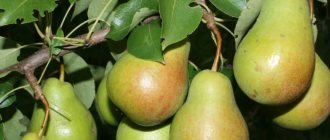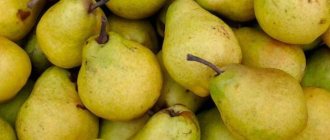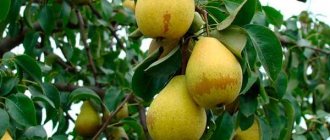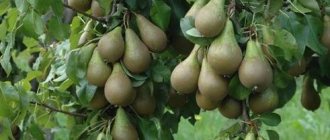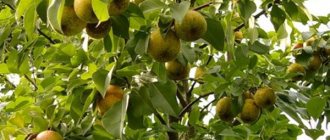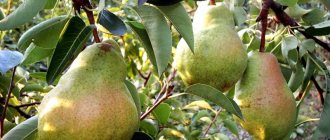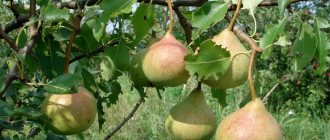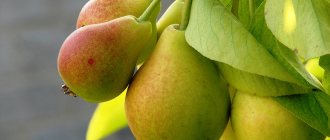The taste and aroma of pears will leave few people indifferent, especially pears such as the Talgar beauty. A description of the variety, photos and reviews will be given in this article.
Possessing numerous advantages - excellent taste, excellent yield, high frost resistance, increased resistance against fungal diseases, shelf life, excellent transportability and a respectable presentation, etc., this pear variety fell in love with gardeners who happily breed it in their summer cottages and on farms ...
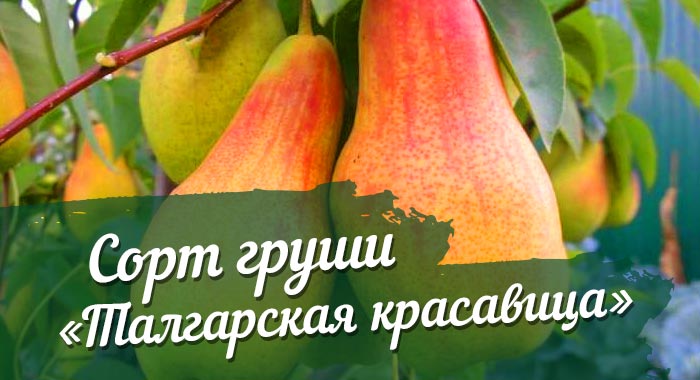
Description of the variety
The pear variety Talgar beauty was bred by the Kazakh breeder A. N. Katseiko from the seeds of the Belgian variety Lesnaya Krasavitsa by the method of free pollination. The place of hatching was the Kazakh Scientific Research Institute of Fruit and Viticulture. Since 1960, the pear has been on the State test. In 1991, the variety was zoned in the North Caucasus region (Kabardino-Balkarian Republic). The Talgar beauty was most widespread among amateur gardeners of the Krasnodar and Stavropol Territories, as well as Ukraine.
Wood
Medium-sized tree, maximum height - 3 m... The crown is shirkopyramidalnaya, of medium density, with hanging branches. The bark on the trunk and skeletal branches is gray, flaky. The predominant type of fruit formations is ringlets.
Shoots are not pubescent, are of medium thickness, straight and brown in color. There are many well-defined medium-sized lentils. The buds are large, non-pubescent, conical in shape. The leaves are ovoid, dark green in color, smooth with long-pointed ends and jagged edges. The leaf blade is slightly concave. The foliage is located on long petioles.
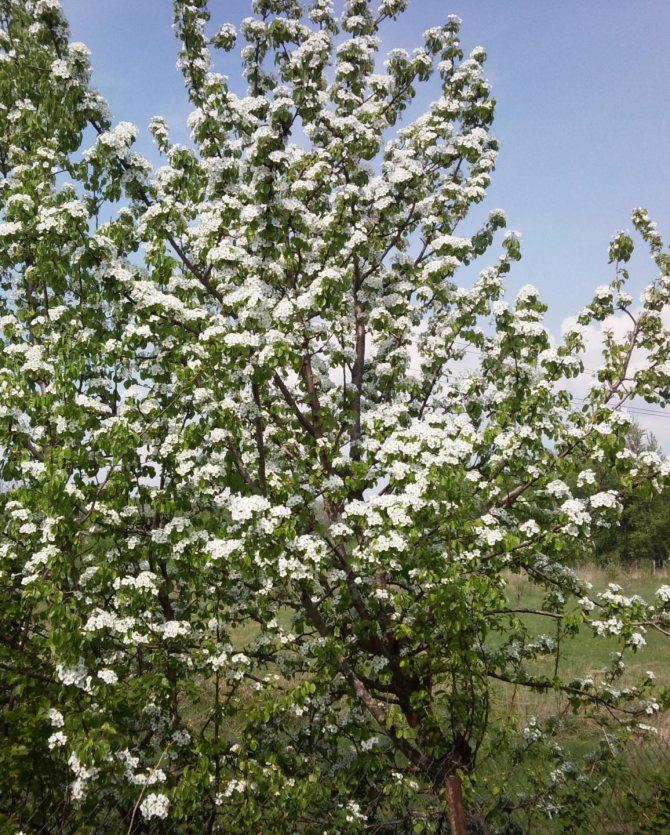

Pear Talgar beauty is a tree of medium height with a wide crown
Fruit
Talgar beauty pears are of medium size. Their weight ranges from 150 to 200 g, but the average weight, as a rule, is 170 g. Sometimes there are specimens weighing 250 g.
The shape of the fruit is very recognizable, elongated-pear-shaped, bottle-shaped, but not always aligned, characterized by beveled tops.
The color of the pears is pale yellow during the harvest period. Most of the surface of the fruit is occupied by a pronounced, red-carmine cover color. The skin is smooth, shiny, oily. Small dots are visible on the subcutaneous surface. The dots are green on the base color, and white on the blush side. The thickness of the skin is medium.
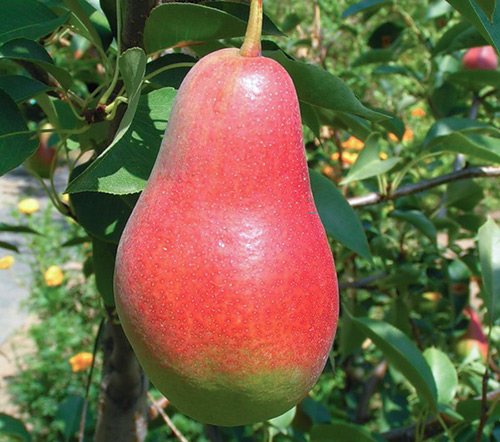

Quite often, the blush covers most of the surface of the fruit.
The peduncle is of medium size, curved in shape. The funnel is shallow, sometimes absent. Cup type - open. The saucer is narrow, deep and even. The heart is medium in size, elliptical type. The seeds are relatively small, closed. The pulp is of a creamy shade, fine-grained structure and medium density.
Talgar beauty is a table variety of pear, the taste of which is determined by the predominance of sugars over acids.
These sweet, juicy, and at the same time crunchy fruits with a faint pear aroma have become an indispensable treat for children. They can be consumed both fresh and processed. The fruits of the Talgar beauty are often used to decorate salads and desserts.
On a five-point scale, professional tasters rate the taste of this pear at 4.6 points.
The fruits of the Talgar beauty have a rich composition. According to chemical indicators, 100 g of pear contains:
- 9% sugars;
- 0.37% titratable acids;
- 7 mg ascorbic acid;
- 15% dry matter per wet matter;
- 54 mg of P-active catechins.
The high content of bioactive substances has a beneficial effect on the body, treats kidney and digestive system diseases. A significant part of the sugars is represented by fructose, so the Talgar beauty can be present in the diet of diabetics or people who are afraid of gaining excess weight..
Photo gallery: pear variety Talgar beauty
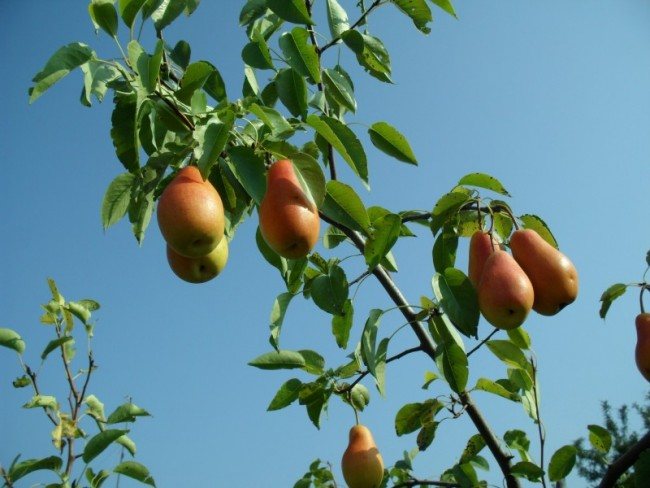

Ripe fruits of the Talgar beauty are firmly held on the branches
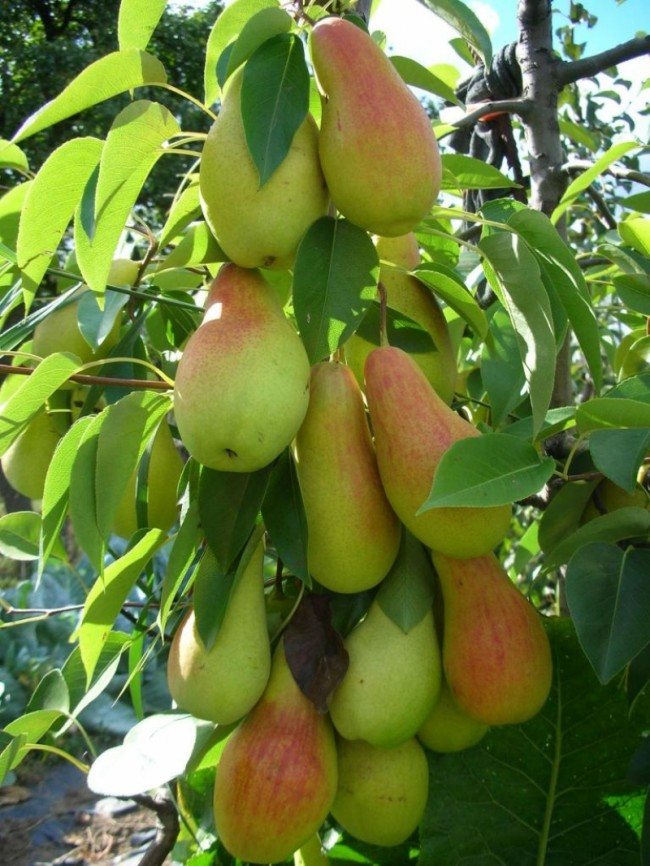

The volume of the harvest of the Talgar beauty increases with each subsequent year.
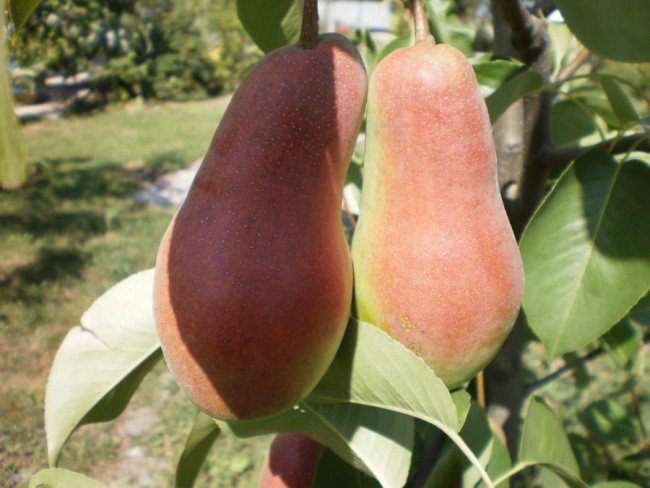

Pears of this variety are characterized by an attractive blush that develops on the sunny side.
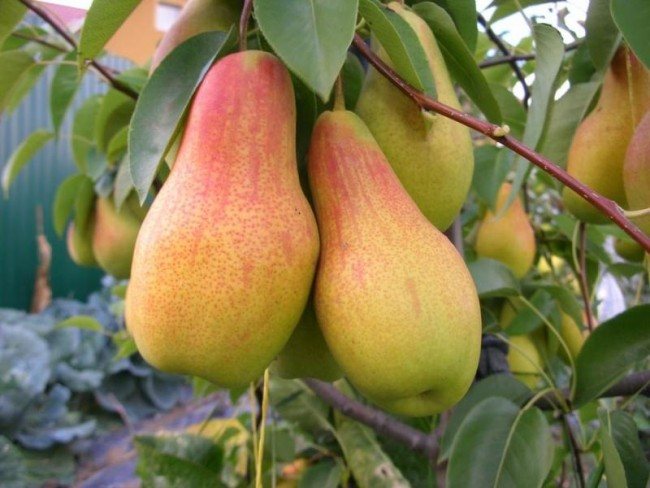

The fruits of the Talgar beauty are elongated pear-shaped, sometimes beveled at the top
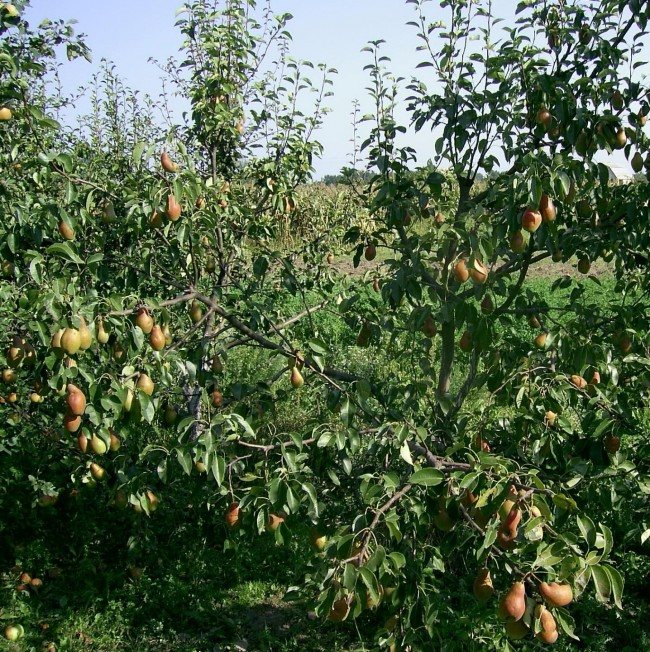

The tree of the Talgar beauty is distinguished by a wide-pyramidal crown of medium density
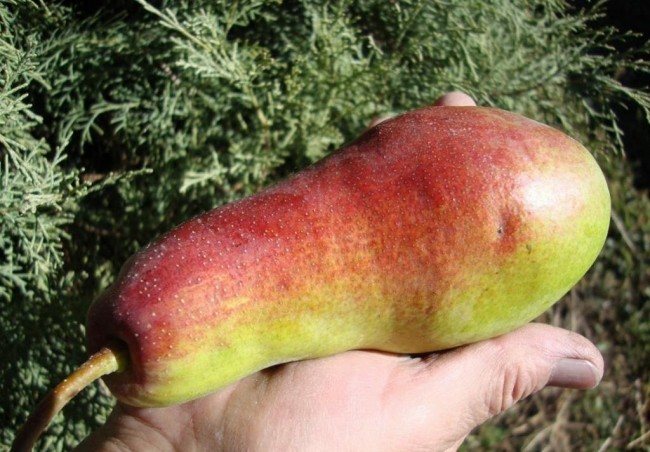

The largest fruits of the Talgar beauty can reach 250 g by weight
Advantages and disadvantages
All pear varieties have both advantages and disadvantages. However, true pear lovers know that every drawback is minimized if the tree is properly cared for.
Table: advantages and disadvantages of the Talgar beauty variety
| Benefits | disadvantages |
| High yield level | The appearance of dark spots on the pulp of pears with late harvest |
| Early maturity | Not everyone likes the crispy flesh of the fruit |
| Fruit attractiveness | |
| Excellent taste of fruits | |
| Frost resistance | |
| Resistance to fungal diseases and pests | |
| Long shelf life | |
| Good transportability |
Advantages and disadvantages of the variety
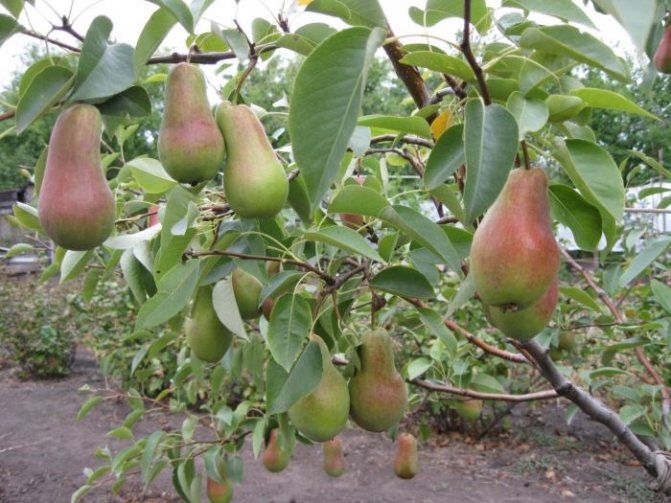

Saplings of Talgar Beauty grow rather quickly and by the age of three they begin to bear tasty fruits.
Each variety has advantages and disadvantages, which, of course, can affect the choice of a gardener. In order not to be mistaken with the choice, it is necessary to determine exactly whether this variety is suitable for growing in your garden. Therefore, we will consider in more detail the strengths and weaknesses of the bred variety. First, let's talk about the disadvantages of the variety.
There are only two of them: when taken late, brown spots appear on the pulp, the crispy pulp is not to everyone's taste.
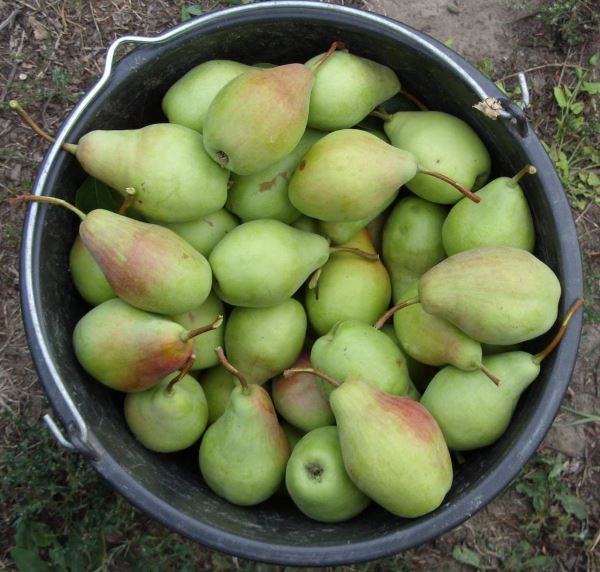

The fruits of this variety must be picked slightly unripe.
As you can see, there are few shortcomings and they are not so significant. But the variety has much more advantages:
- fast ripening of fruits - the variety belongs to the category of early ripening, so the owners of the plantings of the Talgar beauty get the opportunity to eat fresh pears much earlier than other gardeners;
- attractive fruit appearance - the fruits have a beautiful shape and color;
- taste - experts who evaluated the taste of a pear gave it 4.6 points out of 5 possible;
- resistance to low temperatures, pathogens and pests - even if there is no care, the chances that the tree will simply die are negligible;
- shelf life - pears can be stored for a long time, so it becomes possible to transport them to other areas, regions, which is very convenient.
- high yield - therefore, it is this variety that fills the shelves of stores;
And although the tree is really very unpretentious, it is possible to achieve the maximum amount of harvest only if you plant it correctly.
Landing
The survival rate of the seedling and its further development primarily depends on the choice of the place and time of planting. Talgar beauty is an unpretentious variety that successfully takes root even in the unfavorable conditions of the middle lane. However, most amateur gardeners assure that the pear develops and bears fruit best in the southern regions of Russia.
It is recommended to plant a tree with an open root system in the fall, at a time when the leaves have already fallen, but the frost has not yet begun. If it was not possible to land in the fall, you can do it in the spring. In this case, planting is carried out at a time when relatively warm days have come, but the foliage has not yet blossomed.
In the first spring after the autumn planting of a seedling, you can see already blossoming buds on it. But with a spring planting, this phenomenon is rare.
When choosing a place for planting the Talgar beauty, keep in mind that a pear is very demanding on lighting. You need to plant a tree in an open, sunny area on the south, south-west or west side, so that there is enough light for the development of fruit buds and the acquisition of a characteristic blush on the fruit.
At a distance of about 3 m, it is advisable to enclose the selected place with a fence or building. This will help protect the tree from strong gusts of wind without creating shade.
Clay, sandy and very swampy soils are not suitable for pear, and all the rest are considered suitable for growing this crop. If the groundwater level on the site exceeds 2 m, the tree can only be planted on a specially prepared mound. The soil should be loose and contain as much nutrients as possible.
Let's move on to the description of the landing. When planting a pear tree, it is very important to adhere to the following sequence of actions:
- Digging a landing hole. It is recommended to dig a hole for the pear 2 weeks before planting. Its size is determined by the size of the seedling. On average, the depth of the pit is 50-60 cm, and the width is about 150 cm. The soil is removed in layers: the upper fertile layer in one direction, and the lower in the other.
- We apply fertilizers. Add organic fertilizers to the top layer of the earth thrown out of the pit. It is preferable to use 3-4 buckets of rotted manure or compost. If the soil on the site is strongly acidic, mineral-phosphorus fertilizers are also applied - 150-200 g.
- The resulting soil mixture is poured into the center of the pit in the form of a mound.
- We install the support. A peg must be driven into the center of the mound, with the help of which the young tree can correctly form the trunk. Recommended stake length - 140 cm, diameter - 5 cm.
- Preparing the seedling for planting. Cut the damaged roots and branches with a sharp pruner. If the root system is dry, it is advisable to put the tree in water for 2-3 days.
- We plant a pear. Planting a seedling is best done together: one person places it in a pit, and the other covers it with fertile soil. When installing a seedling, it is necessary to carefully spread the roots over the mound, while it is important not to allow the tree to go deep. The root collar should be 4–5 cm above the ground. To avoid mistakes, put a rail or a special board for planting across the pit. Gently tamp the seedling covered with earth with your hands.
- We tie the tree to a peg using a rope.
After planting, you need to water the pear with 2 or 3 buckets of water. It is recommended to carry out the first watering using a sprinkler (directly under the stem of the seedling).
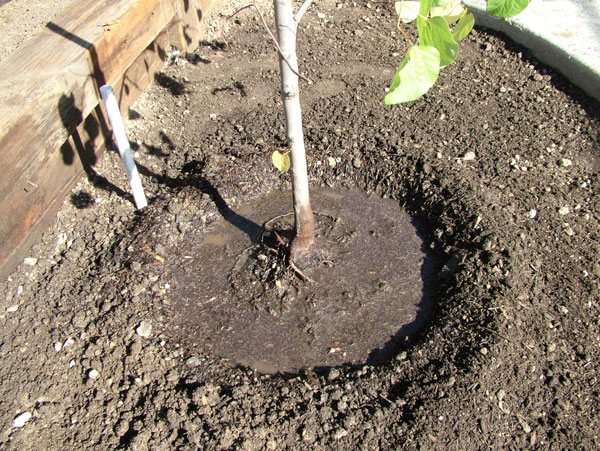

After planting, the pear tree must be watered
To retain moisture, the hole must be mulched with dry foliage, sawdust or hay. A layer of mulch is made about 3-5 cm.
When setting up your own garden with multiple fruit trees, consider planting density. The permissible distance between the pears of the Talgar beauty is 4–5 m. Experienced gardeners, who value every meter of their summer cottage, recommend planting berry bushes on an unused area between trees.
Tree care
Watering
High efficiency of irrigation is achieved with the right combination of water-charging irrigation with vegetation irrigation. Moisture-charging irrigation allows you to start vegetative irrigation two weeks later.
The irrigation rate is determined taking into account soil conditions, groundwater level, soil moisture.
Usually fruit trees are watered 3-5 times a year: the first watering is carried out before or after flowering; 2nd - before the ovary falls off (June); 3rd - 2-3 weeks before ripening of summer apples; the latter - in mid-September, to ensure autumn root growth, or later, in November, for moisture recharge.
Approximate watering rates:
- for sandy loam soils 4–4.5 buckets per 1 m2,
- for loamy - 6–7 buckets per 1 m2;
- for clayey - 8-9 buckets per 1 m2;
- water charging irrigation - 8-10 buckets per 1 m2.
For watering fruit trees, it is recommended to use temporary shallow (depth 13–15 cm) furrows. Two furrows are drawn near the tree: 1st - at a distance of 0.8-1 m from the trunk, 2nd - at 0.5 m from the first. With the next watering, these distances change. Watering can also be done with rings around the tree and by sprinkling.
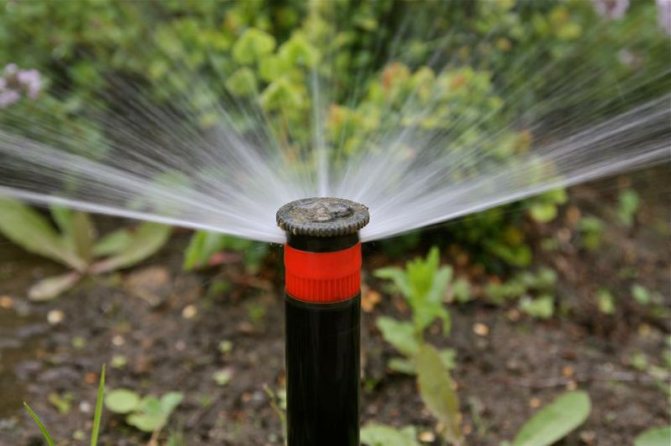

Sprinkler irrigation works best for pears.
The Talgar beauty suffers more not from a lack, but from an excess of moisture. With excessive soil moisture, the vital activity of the suction roots weakens, they begin to die off. In addition, frequent and too abundant watering can provoke a rise in groundwater. With repeated watering in small doses, the tree does not receive enough moisture, the flow of oxygen into the soil is disturbed.
Pruning and shaping the crown
The formation and pruning of the crown means a lot in the life of a fruit tree. If formed incorrectly, the trunk of a tree can even break with strong fruiting. To avoid this, always remove one of the competing shoots of equal strength (there should be no forks).
Since the trees of the Talgar beauty are prone to sagging branches, pruning can correct the shape of its crown. To do this, you need to trim the ends of the branches, leaving the buds (or small shoots) pointing up.
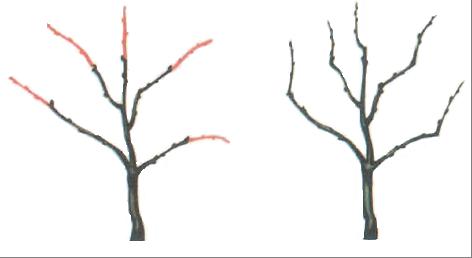

Correct pruning of branches prone to sagging improves crown shape
The crown of a pear tree is usually formed in the form of a palmette or a sparse-tiered type. The construction of a sparse-tiered crown consists in the fact that on the tree, 60–70 cm above the trunk, the uterine (main) branches are laid in two tiers. Each tier usually consists of 3 - 4 branches, with a distance between tiers of 60–80 cm. That is, the crown consists of 6–7 uterine branches, evenly spaced in the peri-stem space.
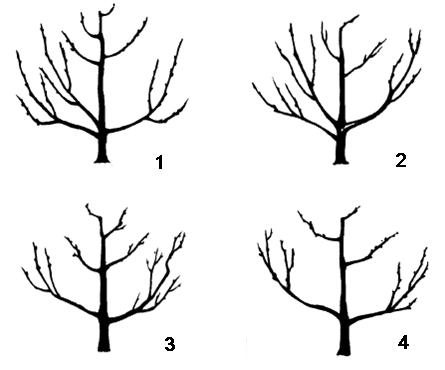

The sparse-tiered crown can have a different arrangement of branches: 1) 3-2-1-1 2) 3-1-1-1; 3) 2-2-1-1 4) 2-1-1-1
In early spring, it is necessary to remove frost-damaged, diseased and excess branches. The next pruning can be done in the fall.
Top dressing
Pear trees love fertilizer and can suffer from a lack of fertilizer. Regular feeding ensures tree health and good yields.
| Season | What fertilizers do we use | Method of application | What contributes to |
| Spring |
| Root dressing | They help to build up leaf mass and improve the quality of future fruits. |
| Summer | After flowering: nitrogen-containing preparations, but the dose is 2 times less than the spring dose. | Foliar application | Increases resistance to fungal diseases. |
| Fall | After harvest: potassium chloride - 1 tbsp, superphosphate - 2 tbsp. Dilute in 10 liters of water. This is the norm for watering 1 m2. Nitrogen-containing dressings are not use! | It is applied after moistening into a watering circle. | Helps the tree prepare for winter. |
An excellent organic fertilizer is poultry manure, especially duck, chicken and pigeon droppings. To reduce nitrogen losses, peat in the form of crumbs (25–30% by weight of the droppings) or superphosphate powder (6–10%) can be added to raw manure. Bird droppings can be applied in early spring as the main fertilizer (0.5–0.6 kg per 1 m2), but even more often it is used as top dressing (1–2 kg of droppings are diluted in 1 bucket of water and applied at 1.5 l / m2). It is best to apply in grooves or holes, which are then immediately covered with soil.
It is better to spray in the evening or in the morning.
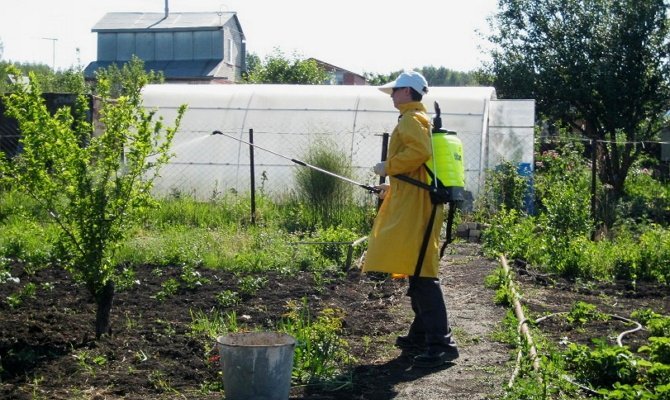

Foliar dressing is done in the morning or in the evening.
Trees need trace elements. On acidic soils, there is a lack of magnesium, then dolomite limestone is added. On calcareous soils, it cannot be used; instead, trees are sprayed at the beginning of shoot growth with a solution of magnesium sulfate (1.8%). With a lack of copper, the shoots begin to dry out. In this case, copper sulfate (0.2%) is usually added in the form of foliar dressings.
How to fertilize a pear - video
Care
It is possible to increase the volume of the harvest, improve the decorative and taste qualities of the fruits of the Talgar beauty only with the help of timely care. It includes the following activities:
- watering;
- pruning;
- fertilization;
- spraying against pests and diseases;
- mulching;
- insulation of boles.
Watering
Watering the pear tree is necessary in spring and summer. It is impossible to indicate the exact dates of watering, as they depend on weather conditions. The irrigation rate with the average rainfall is 3 buckets per 1 sq. m area around the trunk.
Intensive watering is required in hot and dry weather. Also, special attention is paid to the tree in August, since this month flower buds are laid to form the future harvest.
Sprinkler irrigation is considered the best way to water a pear, in which a sprayer with multiple holes simulates rain. To prevent spray of water from scattering over the area, the spray pressure is made weak. The duration of such watering should be at least 2 hours.
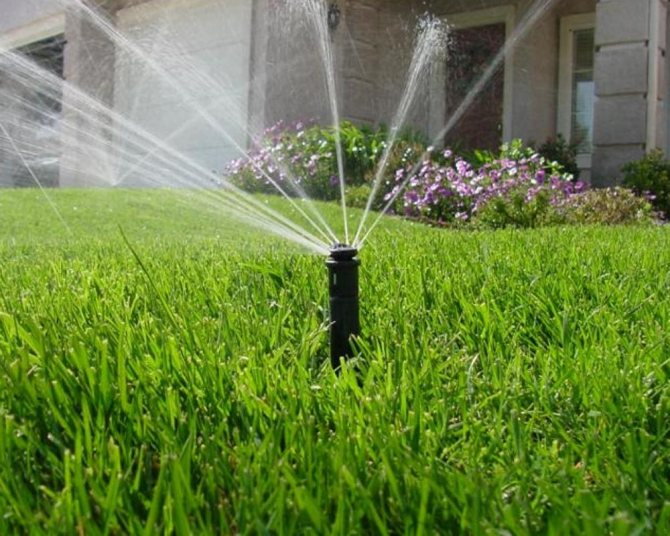

The best pear irrigation system is sprinkler irrigation
At the end of August, watering is completely stopped until spring... Flooding of the root system in the cold season has a negative impact on the further winter hardiness of the variety.
Pruning
Pruning the branches of the Talgar beauty will allow you to properly form the crown to increase the yield and prevent diseases.
The first pruning is done after the young are planted. If it is a 2-year-old seedling, then the skeletal branches should be cut first. For this, branches are selected that are located at approximately the same distance, and 4 of them are cut off. In addition, in order for the tree to develop safely, the side branches are shortened by 1/4 part. In this case, each conductor is left at least 30 cm higher. If a one-year-old seedling was planted, it is shortened, leaving a height of 55 cm.
Pruning of an adult tree is carried out annually in the spring. Remove small, inward-growing twigs that thicken the crown. Sick, dry and old branches are also pruned, which take away the vitality of the plant.
Top dressing
The amount of fertilizers and the frequency of their application depends on the development of the seedling and the soil on which it grows. One year after planting, pay attention to the condition of the young tree. If the growth of shoots is less than 50 cm, then it should be fed with useful microelements.
Fertilizers for pears are applied in autumn and spring.
In the fall, on medium-fertile soils, top dressing is carried out every year. You can use any mineral fertilizers that do not include nitrogen. On average, 1 sq. m you will need 35 g of ammonium nitrate or 20 g of urea, 50 g of superphosphate and 25 g of potassium chloride or 2 glasses of wood ash.
In the spring, the Talgar beauty reacts well to organic fertilizers, for example, rotted manure or humus.They are applied in April 1 time in 2 years at the rate of 2-3 kg of fertilizers per 1 sq. M. m. On poorer fertile soils (sandy), the dose is increased by 1/3.
How to take care of the Talgar beauty?
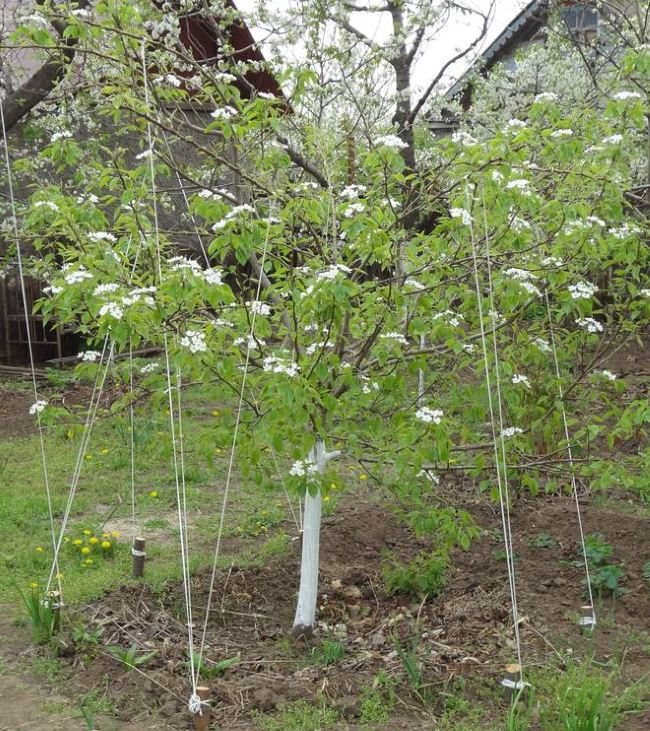

Bending pear branches to stimulate the formation of fruit buds.
As it was written above, planting and care behind this variety are not particularly difficult. The tree is unpretentious. Therefore, it needs minimal maintenance:
- watering - it is necessary to water the tree in the spring and summer, when the air temperature rises. The pear needs abundant watering on dry days. Experts also recommend increasing watering in August, since it is during this period that flower buds are laid. But at the end of August, watering must be completely stopped;
- pruning - in order to form the correct crown of the tree, it is necessary to regularly cut the branches. This will also help prevent the development of various diseases that will negatively affect the harvest. The first pruning is carried out immediately after planting the young;
- fertilization - when wondering what year the pear bears fruit, it should be borne in mind that it depends on care and, in particular, on the presence of fertilizers in the soil. To understand exactly when it is necessary to fertilize the soil, you should first assess the condition of the seedling, as well as the soil. In particular, it is recommended to do this one year after planting. If you notice that the growth of shoots is less than 50 cm, then it's time to think about feeding the roots. In the spring, organic fertilizers are suitable, and in the fall it is better to give preference to mineral fertilizing;
- spraying against pests - will help protect the tree from diseases that can negatively affect the amount of the crop obtained or even cause the death of the seedling. You can use not only chemicals, but also spray with special infusions. For example, an infusion of chamomile, nettle or calendula;
- mulching - when the temperature drops to 10 degrees Celsius, the risk increases that the roots of young seedlings will freeze. To protect the tree, it is necessary to sprinkle the area of the trunk circle with mulching material. Not only manure or humus is suitable, but also peat. The thickness of the powder layer should be no more than 7 cm;
- insulation of boles - for the winter, the pear must be insulated, they do it with the help of artificial and natural materials. The stem is tightly tied and sprinkled with earth a little.
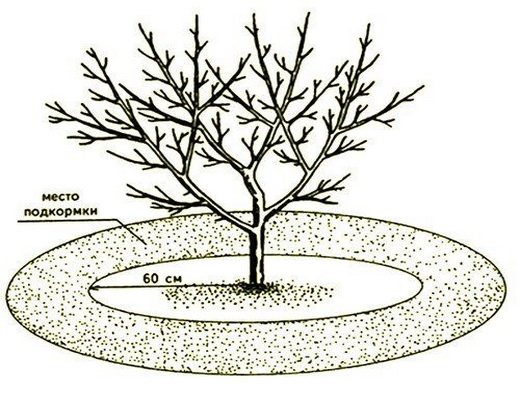

Fertilizing and watering the pear must be done in the shallow grooves of the trunk circle.
Some gardeners prefer to continue insulating the boles even in winter. During this period, they actively use snow and soil for insulation. With their help, gardeners produce a compaction of the trunk circle. The effectiveness of this procedure has been proven, but not every amateur gardener is ready to provide full tree care.
Pollination
The Talgar beauty belongs to the self-infertile species. That is why pollinators are needed for fruit to set on the pear.
To attract them, it is recommended to plant other varieties of pears in the immediate vicinity of the Talgar beauty. The most suitable varieties are considered to be such as Kucheryanka, Hoverla or Conference.
Transfer
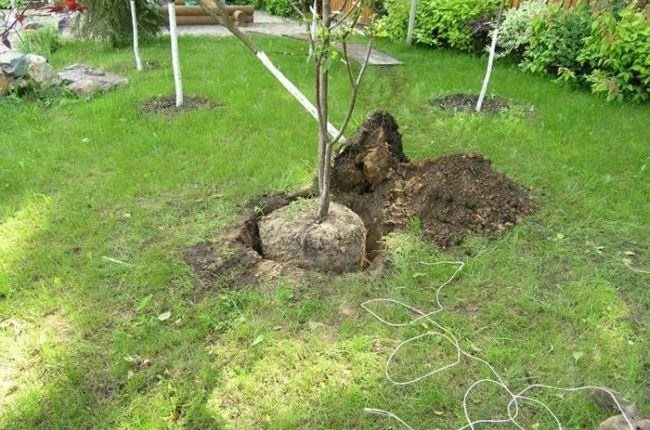

An adult pear tree should be replanted with as large an earthen ball as possible.
The described pear variety has an extremely negative attitude towards transplantation. And since trees do not tolerate transplanting well, experts always recommend planting them in a permanent place. However, there are still situations when it is necessary to perform a transplant. In order not to harm the tree, you must adhere to some rules.
- Transplanting is allowed only in October.
- The tree should be dug with a clod of earth.
- Before you can dig up a tree, you need to water it abundantly.
- If the tree is more than 3 years old, then it is dug in at a distance of at least 60 cm from the trunk.
- A new planting pit must be prepared in advance. This means that you can not dig up a tree before a new place is prepared for it.
Correctly determining the optimal size of the hole will help a lump with earth, which was dug out with the pear. Remember that the pit should always be larger by 30–40 see, than a lump of earth.
Protection against diseases and pests
Pear variety Talgar beauty is distinguished by persistent immunity to pests and fungal diseases. Nevertheless, from early spring to late autumn, the tree needs preventive measures - spraying with chemicals or folk remedies to scare off pests such as pear gall mite, coppertail, goldtail and others.
Folk remedies include special herbal infusions (chamomile, nettle, calendula and other plants). The best chemicals to use are fungicides or insecticides. However, trees affected by fungal diseases are rarely cured with the help of such drugs. In these cases, it is better to use special mixtures. For example, when a pear is infected with scab, the trees are sprayed with 1% Bordeaux liquid or 4% copper oxychloride solution.
Colloidal sulfur (25 g per 10 liters of water) will help get rid of powdery mildew. The tree should be sprayed once a week until the disease is completely eradicated.
Fruits affected by fruit rot must be removed from the tree and destroyed. During the budding period and after flowering, pear trees should be treated with 1% Bordeaux liquid.
Growing rules
The main activities in the cultivation of pear trees:
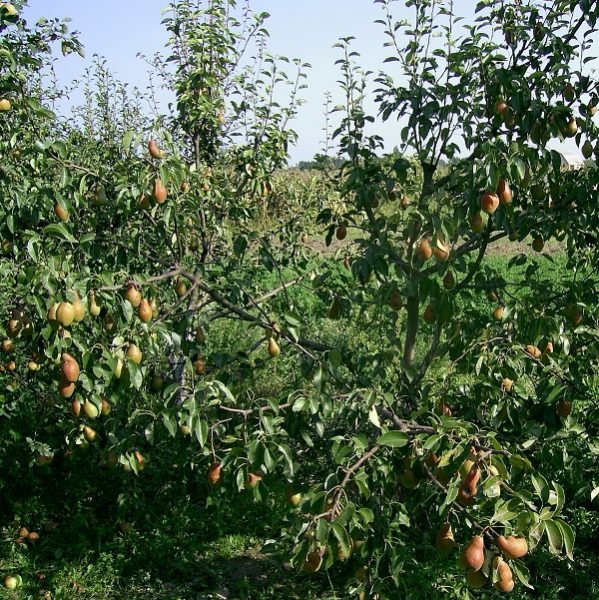

Ripe pears of the Talgar beauty variety, ready to harvest
- Watering. As the soil around the seedling dries out, it is watered at the rate of 2-3 buckets per tree. Adult plants are watered in June, during the period of active growth, and in August, when the fruit is being poured. Water consumption per tree is 25-30 buckets. Watering trees is best done with a sprayer.
- Mulching. The near-trunk area is covered with wood ash, peat or sawdust every year. In summer, mulch prevents moisture evaporation, and in winter it serves as a warming cushion.
- Top dressing... In the spring, in the second year of planting, the seedlings are fed with saltpeter (15 g per 1 m2). And in the fall, a mixture of humus (5 kg), superphosphate (50 g) and potassium salt (40 g) is introduced. To do this, make a trench around the trunk and apply fertilizer mixed with earth into it. Regardless of the stage of development of the tree, such fertilizing is carried out annually.
- Pruning. From the second year of life, the plant forms a crown. First, the most developed lateral branches are chosen, which grow perpendicular to the trunk, four of them are left, and the rest are cut off. The branches are cut so that their ends are at the same level, and the central conductor rises 20-30 cm above them. After pruning, the cuts are treated with garden pitch. The trees are pruned in early spring, before the sap begins to move.
- Sheltering... Before freezing, the trunk of a young tree is treated with lime or special paint and insulated with agrofibre, cotton cloth or paper. This will protect the trunk from cold and rodents. In the spring, the whitewash is repeated to protect the plant from sunburn and parasites.
- Protection. To prevent diseases and repel pests, every year the pear is sprayed with a 3% solution of Bordeaux liquid or ferrous sulfate.
The Talgar beauty is a grateful plant, and with proper care it can please with the first fruits (3-5 pieces) already at 2-3 years of age, the plant fully bears fruit for 4-5 years.
Preparing for winter
Mulching
The roots of young, not fully formed pear trees freeze even at a temperature of 8-10 degrees. You can protect them by insulating the trunk with mulch or other covering materials.
The mulching process should be carried out after the consumption period - in October or November.Horse manure, peat or humus can be used as a mulching material. It is necessary to sprinkle the area of the near-trunk circle around the perimeter of the crown, without touching the trunk. The recommended layer thickness is 5–7 cm.
Mulch made from organic materials also enriches the soil with additional nutrients and protects it from drying out and weathering.
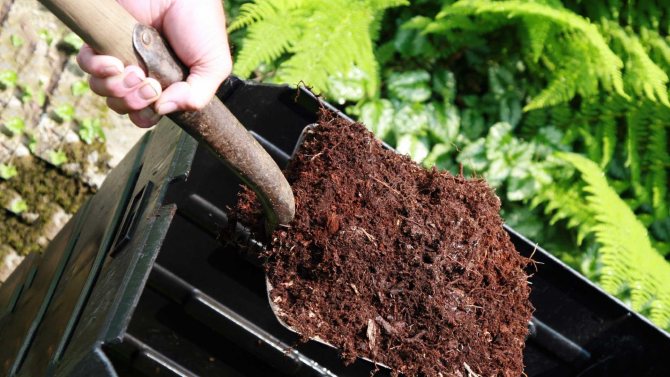

It is advisable to mulch pears with natural materials: peat, humus, sawdust, needles, cut grass, leaves, tree bark
Shelter of boles
You can insulate the pear for the winter with the help of a tight strapping of the trunk with natural or artificial materials. Reeds, spruce branches, wormwood are used from natural materials. Newspaper, roofing felt, cotton fabric or nylon tights are suitable as artificial materials. Such materials will additionally protect the tree from mice and hares. In winter, periodic compaction of the near-trunk circle with snow or earth is effective.
The best way to protect the Talgar beauty from frost and sunburn for a long time is considered to be inoculation with quince stock.
Growing, choosing a seedling
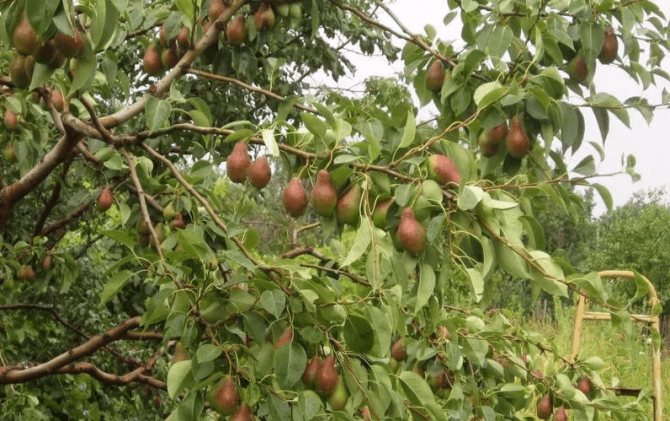

When choosing a pear for planting, pay attention to several criteria, the compliance with which indicates the good quality of the seedlings:
- developed root system;
- no damage to the bark;
- one-year-old height no more than 60 cm;
- the length of the main branches is 5-10 cm, and the trunk is 1 cm in diameter.
It should be remembered that a pear on a quince rootstock takes root worse, but it has better fruit quality. For an open root system, planting is recommended in the fall, for a closed one, spring (April) is also suitable. With an autumn planting (October), buds bloom in the spring of next year. The seedling pit is prepared in advance, at least two weeks before planting.
The location should be chosen, taking into account the illumination (the sun should be enough), and the composition of the soil (avoid high acidity and humidity). Plant a pollinator no further than 10 m. 4–5 m are left between the trees; for a reasonable use of the land, the space between the pears can be planted with bushes. The depth of groundwater should not be less than 2.5 m.
Having chosen a place, dig a hole about 1 m deep, 0.6 m wide. Be sure to fill the bottom with drainage. A layer of earth is laid down, removed from the top (about 20 cm). The soil is preliminarily mixed with fertilizers (potassium sulfate - 70 g, superphosphate - 300 g, humus - 25-30 kg, ash - 900 g). Sheltered from the rain, the pit stands like this.
The day before planting, the roots of the seedling are left in a magnesium solution (3%). After that, the root system is treated with a liquid mixture of clay and manure (2/1), dried a little.
Pear planting scheme:
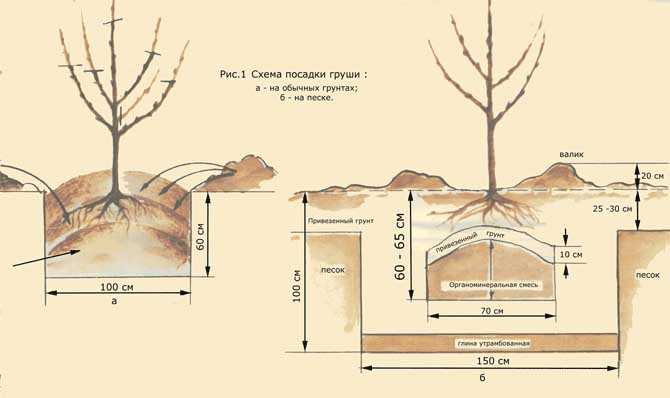

Landing:
- A peg is driven into the bottom of the pit and covered with a mound of earth.
- The seedling is placed on a mound, one person holds it in an upright position, the second straightens the roots neatly.
- Cover the hole with earth, slightly shaking the pear by the trunk so that there are no voids left between the roots.
- Tamp the soil around the tree, make sure that the root collar rises above the ground at a height of 4–5 cm.
- Tie a pear to a peg driven next to it.
- Water the seedling, water at least 2-3 buckets, near the trunk for the first time, you can use a sprinkler.
The trunk circle is covered with mulch (sawdust, straw, peat, 3-5 cm layer). It is good if the seedling is protected from the winds by a fence that will be nearby. Talgarka does not tolerate clay soils, sandy and waterlogged. Sour soil is suitable for planting, but first you need to add 150-200 g of mineral-phosphate fertilizers per 1 sq. m.
Transfer
It is recommended to plant the Talgar beauty immediately to a permanent place, since it does not tolerate transplants, especially at the age of over 4 years.... But if such a need still arises, it is important to adhere to the following rules:
- The transplanting process is best done in the fall (October).At this time, the pear will have time to take root in a new place before frost, prepare for wintering, and start growing in the spring.
- It is necessary to dig a pear tree of any age together with a clod of earth. This will not disrupt the interaction of the root system with the soil, and there will be much less damage to the roots.
- An old tree (over 15 years old) can only be safely dug up with the help of technology. However, the probability that the roots will not suffer is rather small, and often such plants do not take root in new places.
- Before digging a young tree, about 4 buckets of water are poured under the trunk circle. Then the earthy clod can linger on the root system.
- If the pear is 3-5 years old, then it should be dug in at a distance of 60 cm from the trunk. In this case, the earthen lump should be cone-shaped, up to 70 cm long.Adult trees dig in at a distance of 110 cm, their lump will be at least 1 m.
- A planting hole in a new place is prepared in advance, ennobling the earth with fertilizers in the same way as when planting. The size of the hole is made 35 cm wider and deeper than a coma with earth.
- When installing a pear in a pit, the root collar must not be allowed to deepen. As with planting, it should be at least 5 cm above the ground.
- The pit is covered with earth and tamped. The tree is abundantly watered and mulched.
Pests - table
Talgar beauty is resistant to most diseases, even to scab, which affects most other varieties of pears. However, trees of this variety can be attacked by parasites.
The most common pests that do not spare pear trees are leafworm aphids, red fruit mites, and moths.
| Pest | Signs of defeat | Control methods and prevention |
| Leafworm aphid | Insect colonies may be visible on young shoots and leaves. The leaves curl up into a tube and begin to dry out. |
|
| Red fruit mite | The appearance on the leaves of small light spots, which then merge. The leaves turn rusty gray, as if dusty. | In case of mass reproduction of ticks, 2-3 spraying is carried out (from the moment the buds open to the protrusion of the buds). Insectoacaricides can be used: Fufanon, Fitaverm, Danadim. |
| Moth | Dark spots on fruits, around which rot circles quickly appear. |
|
Pear pests in the photo
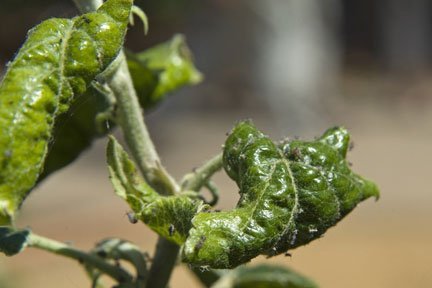

Leafworm aphid damages leaves and young shoots
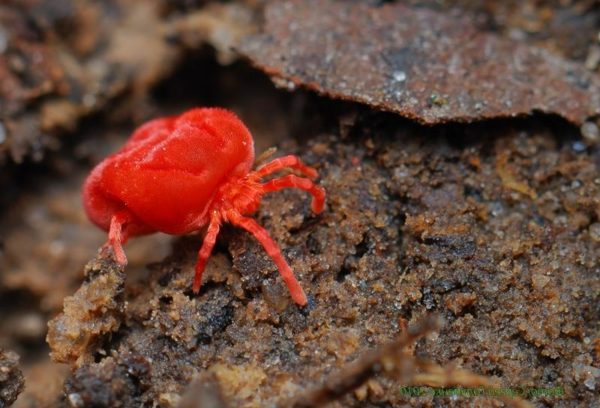

Sucks juice from leaves, interrupting the process of photosynthesis
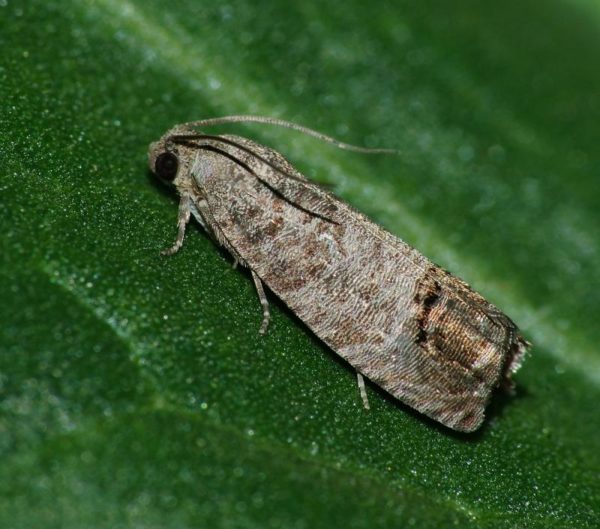

Moth females lay eggs on pear fruits
Diseases
Most pear diseases are caused by various fungi. Fortunately, the Talgar beauty is resistant to such diseases, even to the ubiquitous scab. Pear trees of this variety can suffer from fire blight. The causative bacteria infect flowers, leaves, ovaries, young shoots, even the stem and the root collar. Evidence of the disease is the sudden wilting and blackening of inflorescences, leaves and shoots in spring, which looks like a burn. Then mucus begins to ooze from the affected areas, at first it is white, and when it dries it turns brown. In summer, on diseased shoots, the bark becomes covered with bubbles and cracks.The disease is spread by raindrops, wind and various insects, including bees.
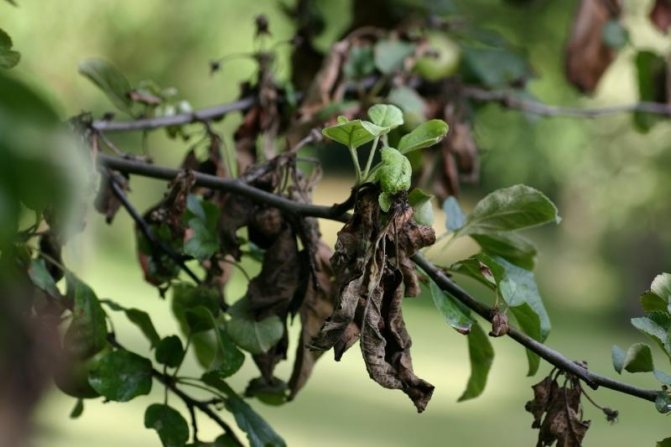

A dangerous disease that primarily affects pears
To prevent this disease, it is necessary, first of all, to buy only proven, healthy planting material. When a disease occurs, quarantine should be observed and the foci of the disease should be immediately eliminated.
Adherence to agricultural practices when growing seedlings helps well, as this increases their viability and resistance. As chemical methods of control, treatment with Bordeaux liquid or other preparations containing copper (for example, Abiga-peak) is recommended. It is best to process during flowering. Considering that not all flowers open at the same time, spraying should be repeated.
Processing is carried out in dry and calm weather. If it rains, do not spray.
Pollination
The Talgar beauty is self-infertile, therefore, it needs pollinators to set fruits. Since this variety belongs to the autumn, pear trees of similar varieties are planted next to it.... The most suitable of them are considered Hoverla, Kucheryanka, Favorite Klapp and Conference.
Photo gallery: the best pollinators for the Talgar beauty variety
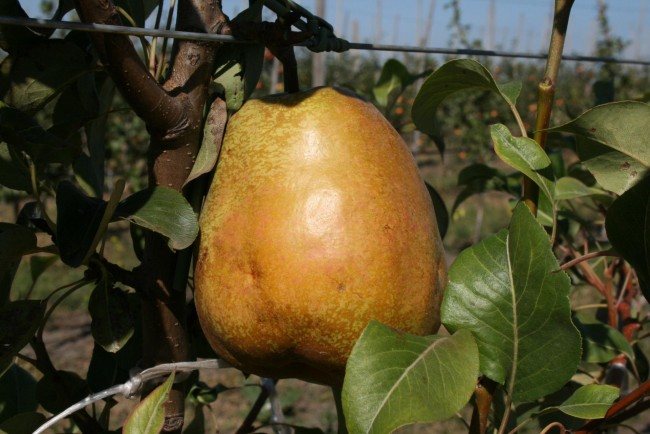

Hoverla is an excellent pollinator for autumn and winter groups of varieties with high activity of pollen grains.
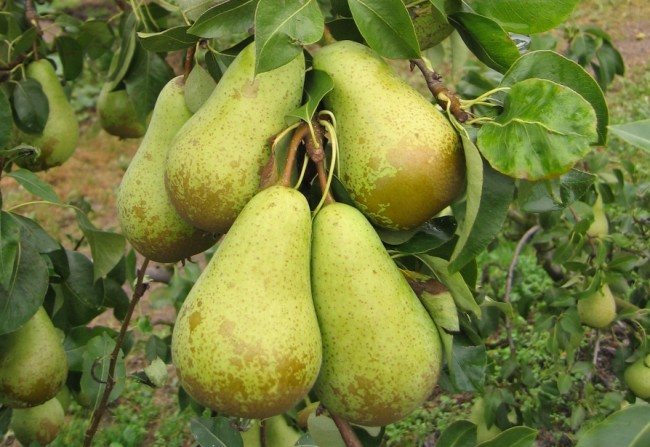

Variety Conference is distinguished by abundant and regular fruiting
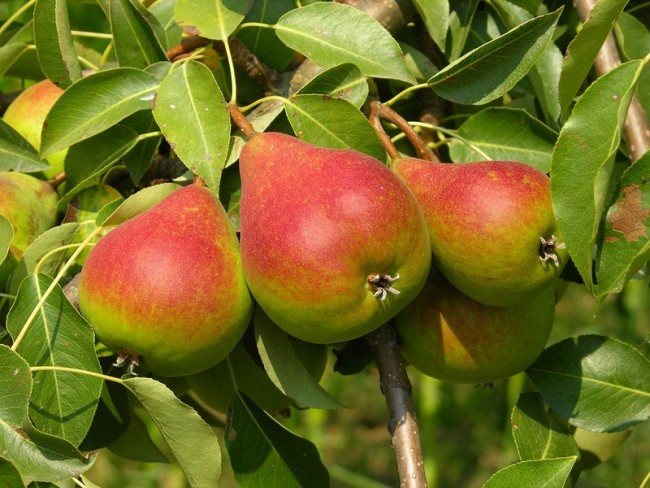

Clapp's favorite is one of the most common pear varieties
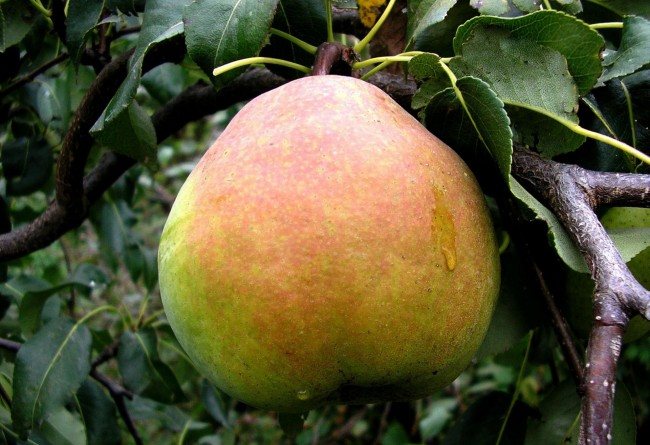

Kucheryanka is a variety that is unpretentious to growing conditions
Description of the crown
The tree of the Talgar beauty is low with a medium leafy crown. The branches that form the crowns extend from the trunk at an almost right angle. The bark has a grayish tint and moderate peeling. The fruits are mainly formed on the ringed branches. The buds are cone-shaped, large and not fleecy. The leaves are large, dark green in color, ovoid with small notches. The leaf plate is smooth, concave, and has no pubescence.
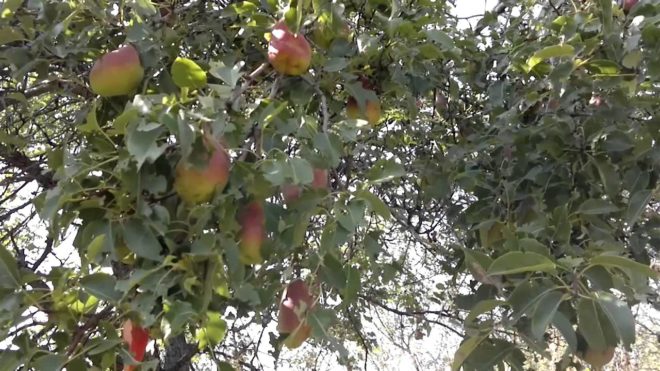

To grow a pear of this variety, it is necessary to study its features.
This variety is not self-pollinating, so three varieties are suitable as pollinators: Hoverla, Conference and Lyubimitsa Klappa.
Harvesting and storage
Pear variety Talgar beauty is distinguished by its early maturity. It begins to bear fruit after 4–5 years after planting, although there are cases when the first fruits (3-4 pears) appear after 2–3 years.
Even in strong winds, the fruits are firmly held on the branches.
The fruits ripen at the end of September, but the consumption period begins in October or November. Throughout the entire fruiting, pears hold tightly to the branches, do not crumble even with a strong gust of wind and are not damaged by pressure. However, late harvesting is not recommended, as this can lead to a loss of taste and presentation of the fruit.
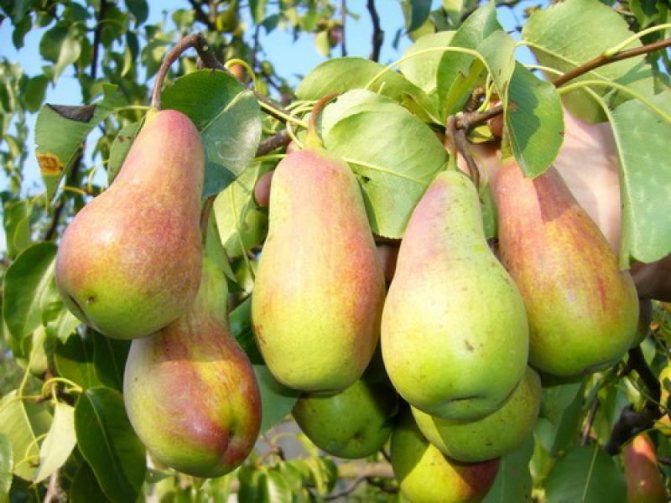

The fruits of the Talgar beauty are highly transportable and do not turn brown during storage.
The yield level of the variety is assessed as high, since the fruiting is abundant and increasing annually. Good transportability of pears is also noted.
Under ordinary storage conditions, the fruits retain their presentation for up to 2 months. In a cellar or storage with artificial cooling, the longevity of the crop can last until December, and in the refrigerator, the shelf life is increased by several more months (until February or March).
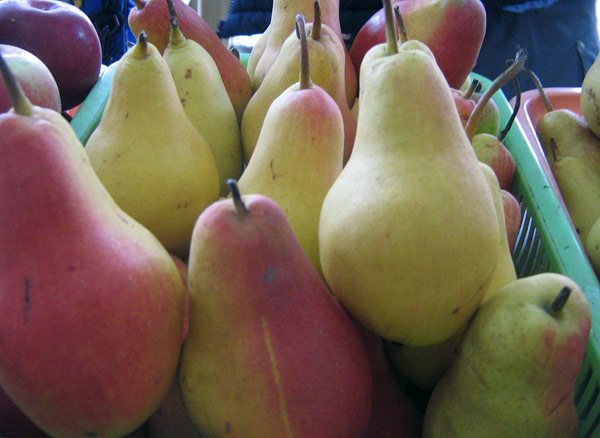

The fruits of the Talgar beauty are stored longer in the refrigerator
Features of the cultivation of "Talgarka"
For the cultivation of an unpretentious variety, standard agricultural technology is used. The pear does not have many features to consider when growing.
Landing
The tree is most often planted in the spring. In the southern latitudes (the main regions of cultivation of the variety), autumn planting is also quite acceptable, but you will need to take care of the shelter of the seedling for the winter.The distance between medium-sized trees of the Talgar beauty should be at least four meters with five-meter spacing. There are no more peculiarities of growing conditions and planting process.
Tree care
When caring for the crown, you need to take into account the following nuances:
- The natural shape of the crown is prone to spreading, so a bowl-shaped formation with a notch of the central conductor would be the most logical solution.
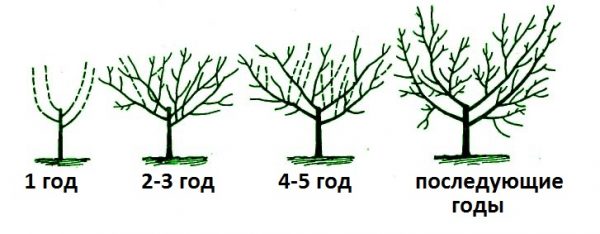

The crown of the Talgar beauty is best formed in the form of a bowl
- Skeletal branches growing almost at right angles from the trunk are under great stress in productive years. Since the wood of the Talgar beauty is quite fragile, it is worthwhile to take care of installing supports under the branches in advance.
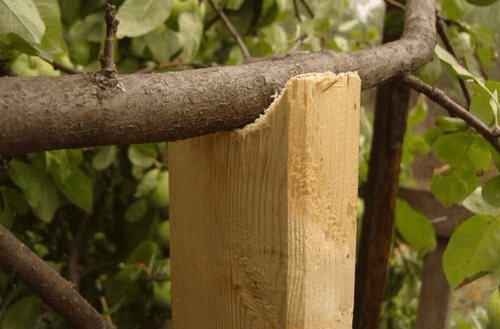

The wood of the Talgar beauty is characterized by fragility, therefore, in productive years it is worth installing supports under the branches
Do not forget to carry out standard types of pruning: sanitary, regulating (thinning) and supporting fruiting (shortening).
Young plants are watered 10-12 times during the season for 3-4 years. As they grow older, the trees acquire the drought resistance characteristic of the variety, therefore, the amount of watering is reduced to two or three per season, depending on the rate of precipitation. During a prolonged drought, it is not worth allowing the soil to dry out; it is better to water the plants once again. If all the necessary nutrients have been introduced into the planting pit, fertilizing begins according to the standard scheme 3-4 years after planting.
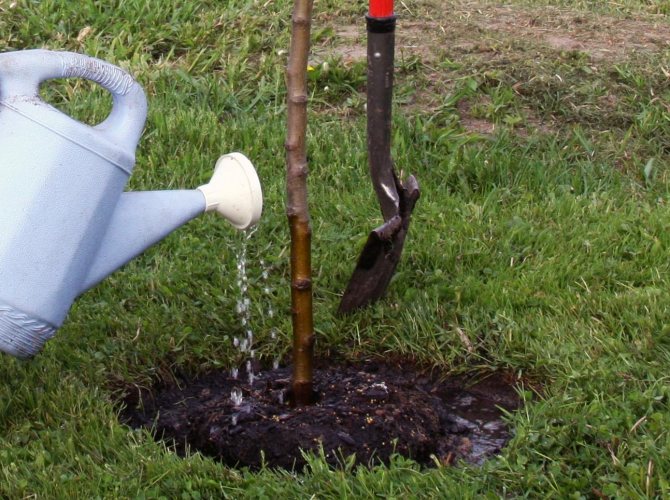

Talgar beauty needs to be watered and fed, like any other pear
A high degree of resistance to fungal diseases makes it possible to dispense with preventive measures when protecting plants. If diseases cannot be avoided during the rainy season, fungicides are traditionally used to combat them.
Protective sanitary and preventive works are also the most effective against possible damage by pests. In order not to have to deal with huge colonies of harmful insects, it is better to prevent their appearance.
Reviews of gardeners about the Talgar beauty
The pear is awesome in taste. Crispy at first, then soft, like a marshmallow!
Igor
When you said that the best apple is the Talgar beauty pear, you could agree with you. Because this pear is eaten with a crunch, similar to our Chinese, of which it is a relative. But only a pear has always been valued and appreciated not for its crunch, but for its oily, tender pulp, juiciness and aroma inherent in European varieties, and you can crunch an apple as well. I know people who just drank and threw out the vaccinations of the Talgar Beauty.
Due to return frosts, we may not have apples. The forest beauty can also get very cold. And there will always be “talgarka”. In some years there may be little fruit, but nothing else will come at all. In terms of yield, hardly any sort of apple can compare with it. And the price is always high for these pears. And of course, it makes no sense to talk about tastes. Someone likes the oiliness of the Forest Beauty. For me, "Talgarka" is tastier. Clones can be different, and depending on where it grows. Probably, the taste of a pear can be different in different places.
In our conditions, the fruits are also sweet and beautiful. But the taste is inharmonious, although pleasant! I cannot say that such an undemanding and problem-free variety: for some reason, my bark has cracked and just lagged behind, although other varieties grow nearby and this is not observed. I decided to start up the variety for re-grafting! Mainly due to the fact that the pulp is not oily, and I love this consistency!
Lus
The pear is problem-free, very fruitful. During her life, and she is already more than 30 years old, there was no harvest for only 1 year. I don't remember the reason anymore, but that year there was no fruit on all the trees. At the end of August, it already becomes edible. Sold on the market off the beaten track. Huge, beautiful ones grow on the tops of the pear. No sores were noticed.Only at the beginning of the season does aphid appear on young tops. But this is quickly corrected by spraying. I would not say that her keeping quality is good. If you collect ripe, then during storage it turns into a "potato". But it keeps well on the tree. It can hang until frost. Usually I collect and bring home, so that it will last for a week, then another. By the way, you can see there are different clones. On my fruit in size, as in the photo in the first message, but on the market I saw very small ones, 10 cm long and without a pink barrel. No longer responds to feeding. Apparently, at this age, she no longer needs them. Although once a season, when tied up, I fertilize and water. At my neighbors, the Talgar beauty was planted with me at the same time, it grows without care, no one watering it, fertilizing it, and the amount of harvest and the size of pears does not differ from mine.
Natal
All the undoubtedly available pluses of this variety are broken for me by one minus - for me it is completely tasteless. Yes sweetie! But that's all. It’s bad that it is sweet-sweet and absolutely not fragrant. And on top of that, I don't like crunchy flesh of pears. No, not mine!
Apple
Planting and leaving
Although the Talgar beauty does not require special care, this does not mean that there is no need to take care of her at all. The most important thing is to choose the right place to land.
"Talgarochka" loves a well-lit area, better on some slopes. Of course, the soil must be good, fertile. But it still needs to be fertilized and nourished.
Leaving consists in the following simple manipulations:
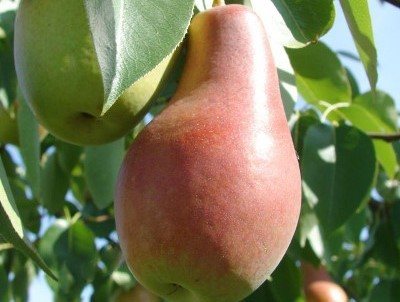

In the spring, carry out prophylaxis against various pests and diseases.- In early spring, loosen the soil around the tree and add manure / compost / humus.
- In summer, the plant should be fed with complex fertilizers.
- Abundant watering is required four times per season.
If you have a desire to get a Talgar beauty of small stature, then you can graft a dwarf rootstock to it. This will not affect the quantity and quality of the crop.
With late harvest, dark spots and spoilage of taste may appear on the skin and pulp. But some gardeners note that with a very late harvest, the fruits remain very tasty and rich.
Video: pear variety Talgar beauty
Talgar beauty is a popular pear variety, perfect for those gardeners who devote their summer cottage only free time from their main activity. The tree is unpretentious in growing and year after year will delight you with sweet, attractive ruddy fruits.
The desire to learn something new every day contributes to the improvement of professional skills. Rate the article:
- 5
- 4
- 3
- 2
- 1
(1 vote, average: 5 out of 5)
Share with your friends!
History of creation, pros and cons
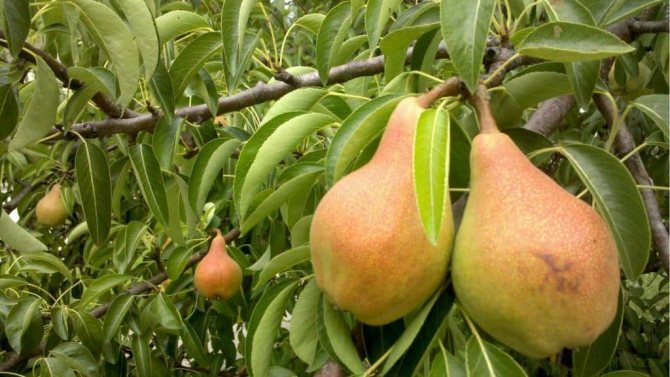

The breeder A. N. Katseiko is considered the author of the variety. He worked at the Kazakh Institute of Fruit and Viticulture, and from the seeds of the Forest Beauty (Belgian variety) received a new type of pear, which is also called Almaty. The Talgar beauty has been tested since 1960, and 31 years later she was included in the State Register for the North Caucasus, the Kabardino-Balkarian Republic.
The pear has become widespread in the Moscow region, in the middle regions of Russia. This was influenced by its high winter hardiness, the tree can withstand frosts at -30 ° C. The unpretentiousness of the variety is confirmed by its resistance to diseases and quick recovery even after severe frostbite.
There are practically no minuses, someone does not like the crispy pulp and poor keeping quality of overripe fruits, but these are trifles compared to the early maturity and regularity of a high yield.
Landing features
For planting a pear seedling, choose a sunny, well-heated place. The soil should be fertile enough, without close groundwater. For a seedling, it is necessary to dig a hole about 70 cm deep. At its bottom, a mound of earth mixed with humus is poured.If the soil is clayey and dense enough, a bucket of sand is additionally introduced into the pit.
Landing is most convenient for two people. One will hold the seedling and spread the roots, the other will evenly cover it with earth. Immediately after planting, the seedling is tied to a peg with twine. The binding is carried out using the "eight".
Attention! Before planting, the seedling is soaked in water with the addition of a root formation stimulator. For example, you can use "Kornevin" or "Heteroauxin".
After planting, the pear must be watered abundantly. In this case, water is needed not only for irrigation, but also for uniform soil settling around the roots. In the future, watering is carried out as the soil dries out. The trunk circle can be additionally mulched. This will reduce the amount of watering.
